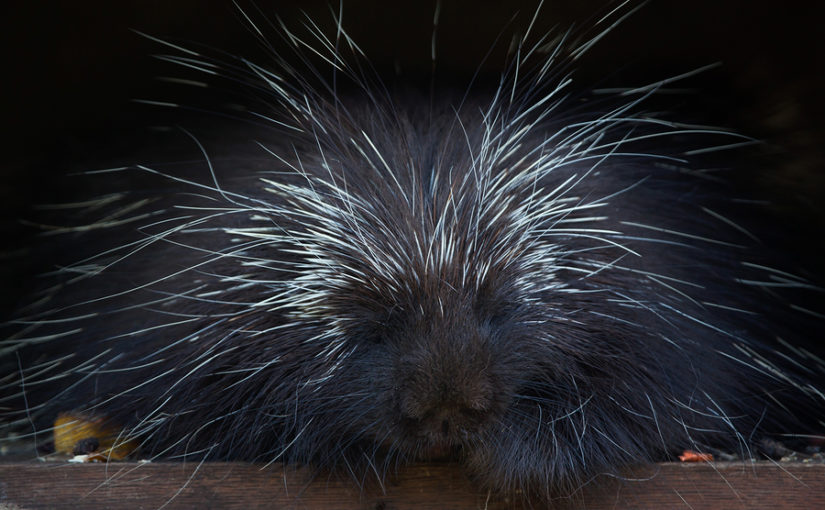Porcupine: Erthizon Dursatum
DESCRIPTION:
Porcupines are the second largest rodent next to the beaver. They have stout bodies, short legs, short thick tail and guard hairs that have been modified to quills. The animal in total length head to tail measure between 700 mm to 1290 mm and weigh 4-18 kg. The teeth are stout, grown constantly and are enamelized. The young are dark at birth and tend to become more yellow as they grow. The color is usually determined by the number of long thick guard hairs which can be as long as 10 cm.
They tend to live in the montaine, sub-alpine forest, pinion-juniper woodlands, cottonwood-willow forest, aspen groves and semi-desert shrubland, and sometimes open grasslands. They eat cambium (flowers and shoots), phloem (vascular plants), buds, foliage of shrubs, saplings, trees (leaves, young shoots, trees bark) and will kill a tree or shrub it they band the bottom and stop the vascular travel of food to the top of the plant. Often times one tree shows heavy damage to the branches and trunk being stripped of leaves, shoots and bark; while other trees next to it are untouched. This suggests that the Porcupine has favorite trees Ponderosa pine, lodgepole pine, douglas fir, and trees that are closer to steep hills, or rocky outcrops.
BEHAVIOR:
Porcupines do not hibernate, do not seem to prefer any particular time as they are seen during the day just as often as at night. They tend to be considered nocturnal. They prefer rocks, hollows and the crotch of trees. They also tend to favor certain feeding sites and will defend their favorite feeding sites but are nomad and don’t have designated territories. They have a home range of 61.7 ha (hectares = 2.47 acres). Vocalizations include grunts, whines and shrill screeches. Vision is poor and smell is excellent. They are polyestrous (several breeding or heat cycles) and polygamous (more than one mating partner). Sex ratio of the born favor females 100:30. Young are single to twin born are precocial (capable of a high degree of independent activity from birth) demonstrated by eating solid food a few days after birth, forage with adult female in 1-2 weeks and weaned at 4 months. They are born with fur and quills that harden shortly after birth. Males are solitary except during concentrated den sites (caves, abandoned buildings, hollows of trees, brush piles).
When demonstrating alarm reactions they will immobilize in a hunched position with quills erect and pushing toward the enemy. They will circle keeping the quills facing the threat.
Quills are dark with white tips, hollow, with microscopic overlapping shingled barbs. They can NOT be ejected, can NOT be launched and are loosely attached and shed easily. Quills must be removed completely with pliers or tweezers. Failure to get the whole quill will result in the quill continued penetration and infection. The quills must be gripped as close to the skin as possible and removed in one quick effective jerk.
PREDATORS: Fishers, coyotes, lynx, bobcats, mountain lions, black bear and human. Animal predators have learned how to turn the animal over and go for the soft unprotected sides and underbelly.
DISEASE: Porcupines do not carry any communicable diseases of concern to humans.
NUISANCE CONCERNS:
- Pet/ porcupine conflicts
- Damage to trees and foliage
- Living under decks, porches, in trees and foliage around the house
- Porcupines are often attracted to tools, aluminum oars, wooden structures consisting of bonded plywood and a layer of glue, car tires, and hoses and leather. It’s the mineral content of these objects that porcupines find attractive.
REMOVAL, EXCLUSION AND RESTORATION:
This animal is usually very difficult to catch unless it is near its den, or it is in a habit of visiting an area. Most instances when it is spotted people ask the animal to be removed for the safety of the household and the pets. They will live under structures such as decks, porches and shed. Capture and removal is required and then exclusion from the site to keep other pioneering animals from inhabiting the vacant spot is required.

